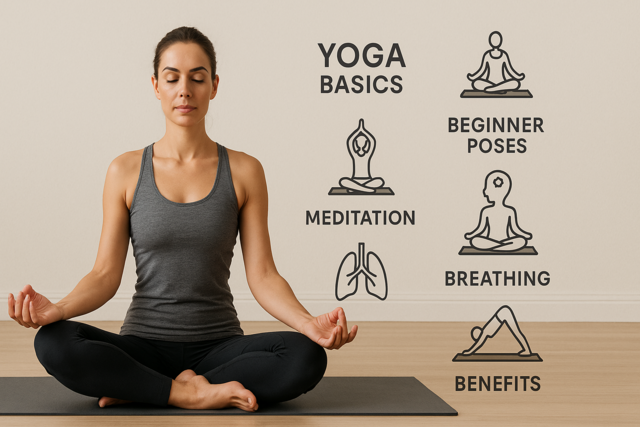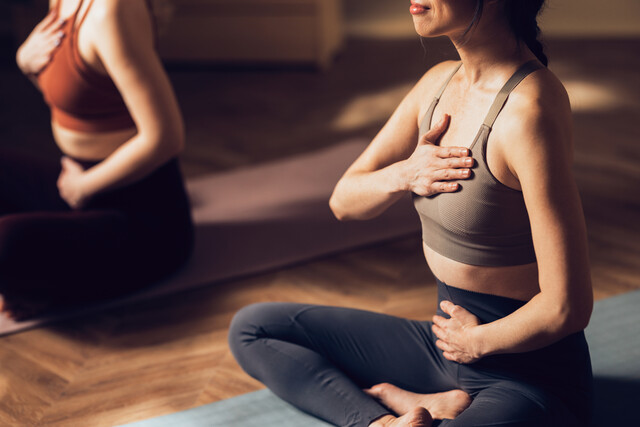Breathing Techniques
-
Normal Breathing
-
Shallow Breathing
-
Deep, Diaphragm Breathing
-
Pranayama Breathing
Breathing is a normal part of our physiology - our bodies breathing without us having to consider every single breath. We can take this for granted; in fact, most of us do! What we might not recognize is when our breathing patterns change, it can be for a good purpose. Remember the "fight-or-flight" response? If you're really threatened, your breathing patterns change, allowing you to either fight your opponent, or run away from it.
What happens, though, if your "fight-or-flight" response occurs every time the phone rings, or the doorbell rings? What happens when you don't notice you begin breathing in shallow rapid breaths, and this becomes your new normal breathing pattern?
You guessed it, you could be developing a bad habit that will lead to a change in the entire physiology of your body that can lead to a downward trend in terms of quality of life, and possibly even lead to illness.
Normal Breathing
In order to teach you how to purposefully relax using breathing techniques, we will first establish what a normal breathing pattern really is.
Become aware of your current, normal breathing patterns. Find a quiet place where you will be undisturbed for a few minutes. If you have pets or small children, ask that someone be in charge of them for a time. If you're at work, perhaps you can find an empty office or room you could use.
Are you having trouble finding a place where you can be alone? This is a symptom of how we live. The more difficulty you are having finding a place to be alone, the more you need to carve out time for yourself where you can be alone.
Now that you have found a quiet place, sit comfortably. You do not have to sit on the floor; you may sit in a chair.
Close your eyes and now just notice your breathing. There is no right or wrong to this. Just notice.
Do you breathe through your mouth? Do you breathe through your nose? Is your breathing obstructed at all, perhaps you have a cold, are suffering from allergies or sinus difficulties. Simply notice all these things.
Now notice the rise and fall of your chest as you breathe in and out.
How many seconds are you inhaling? How many seconds are you exhaling?
OK, now you've been duped.
But this is actually a good thing - to be tricked, that is. It means that you are practicing "mindfulness" simply by being aware of your breathing.
The real truth about your normal breathing is that you can't determine your normal breathing when you think about it because you will immediately begin to breathe more deeply and more slowly. If you want to know your normal respiratory or breathing rate, either ask someone to count when you don't notice, or place a recording microphone near your mouth and do a normal task for five to 10 minutes. Then, listen to one minute of the recording and evaluate how many times you breathe in a minute that way.
For an adult, the normal respirations rate is about 12 times per minute. Unfortunately, most modern adults take about 15 � 20 breaths per minute, this is much faster than the target "normal" rate of 12 breaths per minute.
When we are sick, our respiration rate is usually about 20 breaths per minute, and in some conditions it is as high as 30 breaths per minute. It is estimated that nearly 90 percent of all adults breathe at a fast enough rate to be considered hyperventilation. This is compared to normal recorded respiration rates of people about 80 years ago.
What does all this mean?
When we breathe more rapidly than we should, we lose more CO2 (carbon dioxide) and we take in less oxygen that we should. This means that all the millions of cells in our body are starving for oxygen. Breathing faster will not fix this problem, learning to breathe more slowly and deeply, however, will.
The difficulty is turning this slower and deeper breathing into a habit.
Main causes of hyperventilation or increased respiration rates include lack of physical exercise, mouth-breathing, upper chest/shallow breathing, poor posture, overeating, and stress.
Symptoms of chronically increased respiration rates include constipation, coughing, muscle cramps, anxiety, fatigue, insomnia, nasal congestion, sighing, shortness of breath, and angina.
Notebook Work:
Note in your notebook what your normal respiration rate is.
Also write down any symptoms you may notice that could be due to the way you normally breathe.
What would you like to change?
How do you think it will help you overall?
Shallow Breathing
Shallow breathing is when you only use your upper chest, taking in quick, shallow breaths that do not fully expand your lungs. This occurs during a fight-or-flight response; it occurs when we are upset or angry. Think back to a time when you were really angry, or the last time you saw someone who was really angry. You could hear their breathing, coming in short, hard bursts.
This is called chest breathing. Chest breathing leads to hyperventilation, and is by its very nature shallow breathing. When you only use your chest to breathe, you are not fully expanding your lungs with oxygenated air.
Have you ever experienced a feeling of panic or know someone who feels claustrophobic about being in an elevator, or standing in a very crowded room or line? They are likely underbreathing and experiencing oxygen deprivation. Many of the symptoms of panic and anxiety are due to the lack of oxygen. You feel jittery. You may have tingling of your hands or feet or face. You might feel dizzy or disoriented.
One quick solution is to learn to breathe deeply, and bring in as much oxygen as possible to alleviate most of these symptoms.
Try this. Lie flat on the floor and place one hand on your chest and one hand on your stomach. Breathe normally.
Which hand moves?
If the hand on your chest moves, you are a shallow breather and will experience significant benefits from learning to breathe more deeply.
The good news about your breathing is that simply by noticing your breath, you will learn to breathe more deeply, especially during stressful times when your body actually needs more oxygen.
Stress affects all of us, and our breath or respiration rate is one of the first outward signs we notice. As you just learned, 90 percent of all Americans hyperventilate to one extent or another. This means that 90 percent of all Americans are shallow breathers, and every cell in their body is not functioning at full capacity because they are starving for oxygen.
Learning to breathe deeply is the simplest and yet most powerful way to change your quality of life.
Lie on your back on the floor again, or on a bed if getting on the floor is difficult for you. Do not use a pillow under your head. Place one hand on your chest and the other hand on your stomach or abdomen.
Breathe normally for a couple of breaths. You likely will feel most of your breathing movement underneath the hand on your chest.
Now visualize your lungs. They are very much like strong, elastic balloons. It takes a little bit of effort to fill them up fully, and in order to do that, you actually have to move your diaphragm down into your abdomen. The diaphragm is a strong membrane that separates your lungs from your other organs. Because it is so strong, breathing deeply takes some concentrated effort. It is not hard. You just have to notice.
Fill your lungs with air. Expand them as fully as you can. Notice the hand on your abdomen is now moving. This is what you will want to practice. Proper, deep breathing means that your chest moves very little, and your abdomen moves a lot, because by expanding your lungs to the point of moving your diaphragm down into your abdomen will raise the hand resting on your abdomen.
Practice this until you know what it feels like to take in a really, really deep breath. Hold it for a second or two before releasing it. Be sure to fully and completely exhale. Hold your breath for a second or two, then inhale deeply, raising the hand on your abdomen with the breath.
Pranayama Breathing Exercises
Pranayama is a strange sounding word that comes from India. It is nothing more than learning various breathing exercises for a variety of reasons. Many men and women are taught various breathing exercises when they attend natural birthing classes because breath control has been shown to really help with the birthing process. It helps the mother remain calm, helps to diminish the perception of pain, and helps the mother to control her impulse to push at the wrong time which could lead to tearing injuries.
Pranayama is a Sanskrit word, when broken down means:
pra- moving
na � always
ayama � to extend or stretch
Pranayama is to learn to control your breath. It is an extension of yoga. Pranayama is used in yoga to help the yoga practitioner to breathe into the pose or stretch.
Pranayama, however, is often used alone, and that is what we are discussing here.
Here are two Pranayama exercises to use when you feel yourself becoming stressed or tense for any reason.
Exercise 1: Sit comfortably in a chair, close your eyes and inhale through your nose for the count of eight. Make them measured counts, not fast or slow. Hold that breath for a count of four to eight, and then exhale through your mouth for a count of eight.
After each breath notice how you're feeling. Repeat as needed, each time noticing how you feel. You can even monitor yourself if you have a heart rate monitor, or a blood pressure cuff. Measure your heart rate and blood pressure before beginning this exercise. Then practice this measured breathing for five to 10 minutes, then re-measure your vital signs. With practice, you will notice that both your heart rate and your blood pressure will normalize.
By paying close attention to how you feel, being mindful, you will begin to know when your heart rate and blood pressure stabilize and lower. By practicing this mindful noticing, you are really listening to your body, and your body is answering.
Exercise 2: This exercise will engage both hemispheres of the brain and increase your ability to think both creatively and logically. It is also used to calm and balance your mind.
Sit comfortably either in a chair or in a cross-legged position on the floor. Place your left hand on your left leg and leave it to rest there. Using only the thumb and ring fingers of your right hand you will close off your right nostril with your thumb and inhale through your left nostril for a count of four to six. Now, using the ring finger of your right hand, close off the left nostril and exhale through your right nostril for a count of four to six.
Inhale through the right nostril for a count of four to six. Close off the right nostril with your thumb, open your left nostril and exhale for a count of four to six.
Continue breathing this way, alternating inhaling and exhaling through your left and right nostril five to six times each nostril. Once you have completed that, place your right hand on your right leg and continue breathing normally through both nostrils.


























